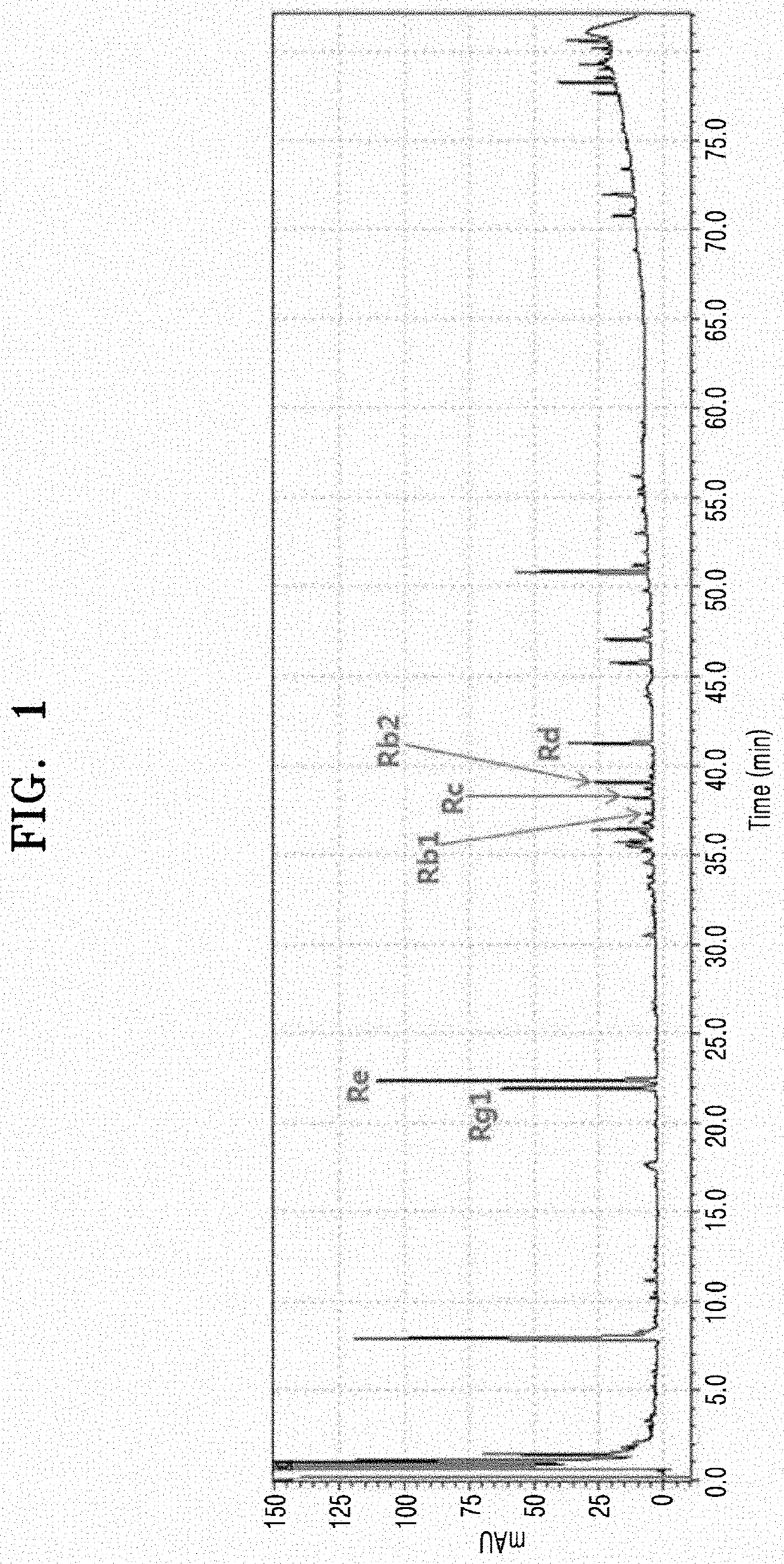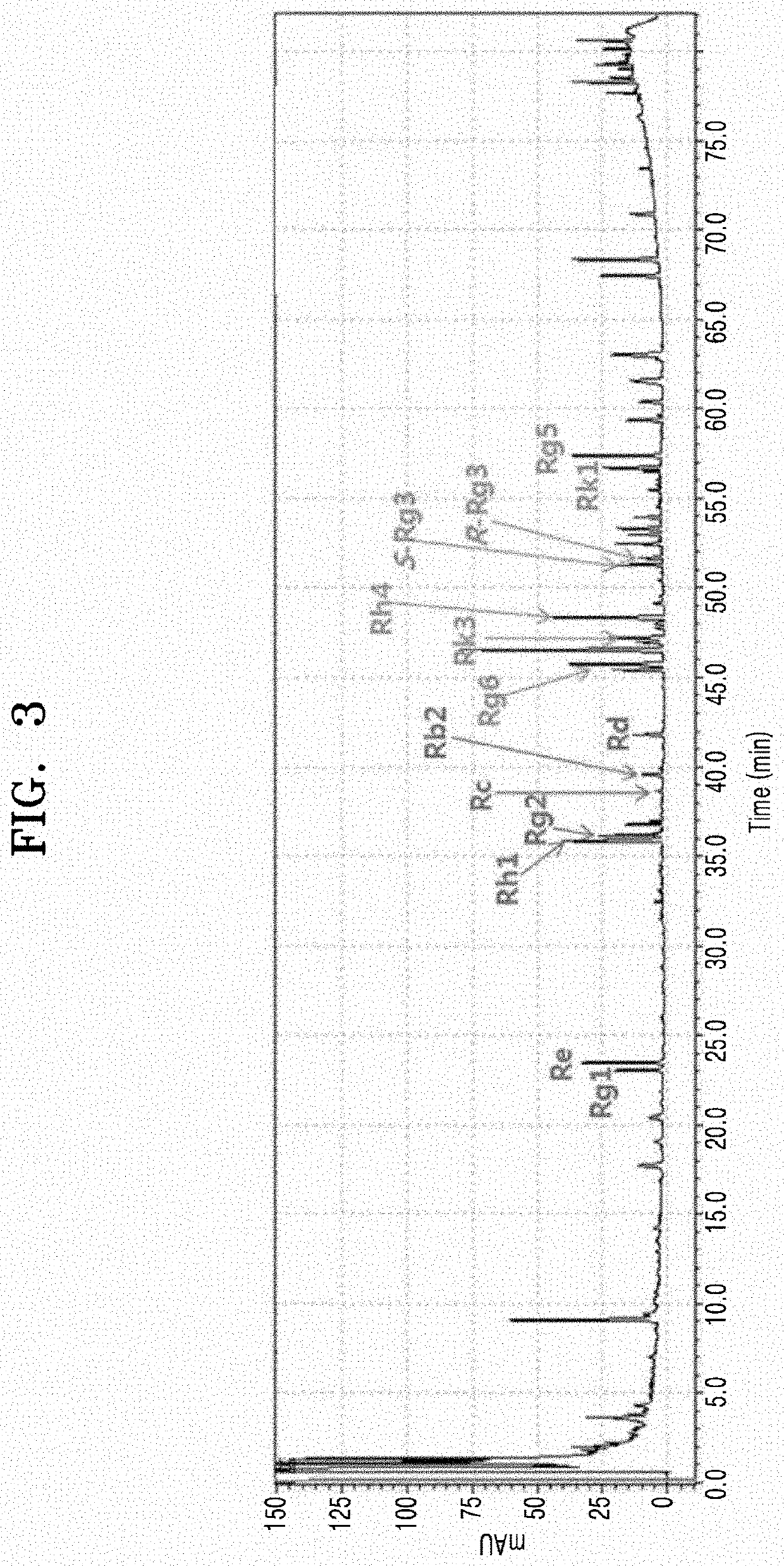METHOD OF PRODUCING GINSENG LEAF EXTRACT INCLUDING GINSENOSIDES Rg6, Rk3, AND Rh4 IN INCREASED AMOUNTS FROM GINSENG LEAF AND USE OF THE GINSENG LEAF EXTRACT
a technology of ginseng leaf and ginsenosides, which is applied in the field of ginseng leaf extract, can solve the problems that ginseng leaves have not proved economically useful, and achieve the effect of improving skin wrinkles
- Summary
- Abstract
- Description
- Claims
- Application Information
AI Technical Summary
Benefits of technology
Problems solved by technology
Method used
Image
Examples
example 1
on of Ginseng Leaf
[0049]A ginseng leaf (i.e., Panax ginseng leaf) used herein was harvested in July from the areas around Ansan-si, Gyeonggi-do, Korea. 2 L of 50% ethanol was added to 100 g of finely cut ginseng leaf, and a reflux extraction process was performed under elevated temperature conditions at a temperature of about 80° C. for 2 hours, thereby obtaining an extract of 50% ethanol. The resulting extract of 50% ethanol was dried to evaporate a solvent therefrom under reduced pressure, thereby obtaining 14.5 g of a dried extract including ginsenosides Rg1 and Re at a weight of 55% or more with respect to ginsenosides Rg1, Re, Rb1, Re, Rb2, and Rd.
examples 2 to 7
i>Ginseng Leaf Extract Using Microwaves (1)
[0050]The extract of 50% ethanol obtained in Example 1 was subjected to a heat treatment process using microwaves. In detail, 200 mg of the ginseng leaf extract was added with 1 mL of 50% ethanol solution to a 10 mL container in a microwave irradiation apparatus (CEM 908005 model, USA). The container was sealed so that the contents of the container were closed from the outside air, and the container was subjected to microwave irradiation under conditions of the irradiation time set to 30 minutes, the microwave power set to 100 W (main frequency of 2,455 MHz), and the irradiation temperature set to 110° C. (Example 2), 120° C. (Example 3), 130° C. (Example 4), 140° C. (Example 5), and 150° C. (Example 6), respectively. Then, a lyophilization process was performed thereon, so as to obtain processed products by the microwave irradiation. Here, the pressure set for the microwave irradiation was 20 atm, and the initial reactant of the microwave ...
examples 8 to 13
>Ginseng Leaf Extract Using Microwaves (2)
[0051]The extract of 50% ethanol obtained in Example 1 was subjected to a heat treatment process using microwaves. In detail, 200 mg of the ginseng leaf extract was added with 1 mL of 50% ethanol solution to a 10 mL container in a microwave irradiation apparatus (CEM 908005 model, USA). The container was sealed, and then subjected to microwave irradiation under conditions of the irradiation temperature set to about 120° C., the microwave power set to 100 W (main frequency of 2,455 MHz), and the irradiation time set to 40 minutes (Examples 7), 50 minutes (Examples 8), 60 minutes (Examples 9), 70 minutes (Examples 10), 80 minutes (Examples 11), and 90 minutes (Examples 12), respectively. Then, a lyophilization process was performed thereon, so as to obtain processed products by the microwave irradiation. Here, the pressure set for the microwave irradiation was 20 atm.
Experimental Example 1: Ginsenoside Analysis of Microwave-Processed Products
[...
PUM
 Login to View More
Login to View More Abstract
Description
Claims
Application Information
 Login to View More
Login to View More - R&D
- Intellectual Property
- Life Sciences
- Materials
- Tech Scout
- Unparalleled Data Quality
- Higher Quality Content
- 60% Fewer Hallucinations
Browse by: Latest US Patents, China's latest patents, Technical Efficacy Thesaurus, Application Domain, Technology Topic, Popular Technical Reports.
© 2025 PatSnap. All rights reserved.Legal|Privacy policy|Modern Slavery Act Transparency Statement|Sitemap|About US| Contact US: help@patsnap.com



